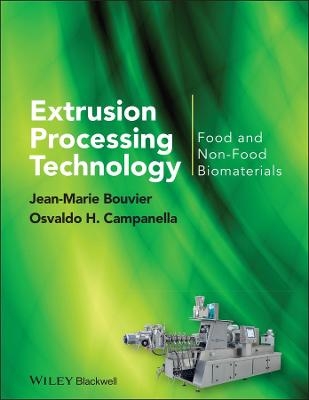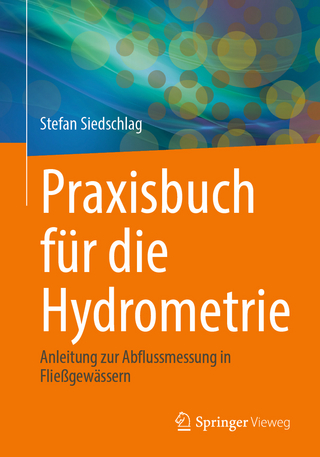
Extrusion Processing Technology
Wiley-Blackwell (Verlag)
978-1-4443-3811-9 (ISBN)
- Lieferbar (Termin unbekannt)
- Versandkostenfrei
- Auch auf Rechnung
- Artikel merken
Extrusion is the operation of forming and shaping a molten or dough-like material by forcing it through a restriction, or die. It is applied and used in many batch and continuous processes. However, extrusion processing technology relies more on continuous process operations which use screw extruders to handle many process functions such as the transport and compression of particulate components, melting of polymers, mixing of viscous media, heat processing of polymeric and biopolymeric materials, product texturization and shaping, defibering and chemical impregnation of fibrous materials, reactive extrusion, and fractionation of solid-liquid systems. Extrusion processing technology is highly complex, and in-depth descriptions and discussions are required in order to provide a complete understanding and analysis of this area: this book aims to provide readers with these analyses and discussions.
Extrusion Processing Technology: Food and Non-Food Biomaterials provides an overview of extrusion processing technology and its established and emerging industrial applications. Potency of process intensification and sustainable processing is also discussed and illustrated. The book aims to span the gap between the principles of extrusion science and the practical knowledge of operational engineers and technicians. The authors bring their research and industrial experience in extrusion processing technology to provide a comprehensive, technical yet readable volume that will appeal to readers from both academic and practical backgrounds.
This book is primarily aimed at scientists and engineers engaged in industry, research, and teaching activities related to the extrusion processing of foods (especially cereals, snacks, textured and fibrated proteins, functional ingredients, and instant powders), feeds (especially aquafeeds and petfoods), bioplastics and plastics, biosourced chemicals, paper pulp, and biofuels. It will also be of interest to students of food science, food engineering, and chemical engineering.
Also available
Formulation Engineering of Foods
Edited by J.E. Norton, P.J. Fryer and I.T. Norton ISBN 978-0-470-67290-7
Food and Industrial Bioproducts and Bioprocessing
Edited by N.T. Dunford ISBN 978-0-8138-2105-4
Handbook of Food Process Design
Edited by J. Ahmed and M.S. Rahman ISBN 978-1-4443-3011-3
About the authors Professor Jean-Marie Bouvier is Scientific Advisor at Clextral, Firminy, France. Professor Osvaldo H. Campanella is a Professor of Agricultural and Biological Engineering at the Whistler Carbohydrate Research Center, Purdue University, Indiana, USA.
Foreword ix
Acknowledgements xi
1 Generic Extrusion Processes 1
1.1 A history of extrusion processing technology 1
1.1.1 The introduction of screw extruders 1
1.1.2 The generic extrusion process concept 2
1.1.3 Extrusion technology in the polymer-processing industry 3
1.1.4 Extrusion technology in the food- and feed-processing industry 4
1.1.5 Extrusion technology in the paper-milling industry 8
1.2 Factors driving the development of extrusion processing technology 9
1.2.1 Process productivity 9
1.2.2 Product innovation and functionality 9
1.2.3 Environmentally friendly processing 10
1.3 The industrial and economic importance of extrusion processing technology 10
1.3.1 In the polymer and plastics industry 10
1.3.2 In the food and feed industry 10
1.3.3 In the paper milling industry 11
1.4 Contents and structure of the book 11
References 12
2 Extrusion Equipment 13
2.1 Extruders 13
2.1.1 The kinematics of extruders 13
2.1.2 The screw-barrel assembly 15
2.1.3 The die assembly 20
2.1.4 The central operating cabinet 28
2.2 Extruder screw-barrel configurations 28
2.2.1 Single screw extruders 29
2.2.2 Intermeshing co-rotating twin screw extruders 31
2.2.3 Screw-barrel configuration and wear 33
2.3 Ancillary equipment 39
2.3.1 Upstream ancillary equipment 40
2.3.2 On-line ancillary equipment 44
2.3.3 Downstream ancillary equipment 46
References 51
3 Extrusion Engineering 53
3.1 Thermomechanical processing in screw extruders 53
3.1.1 Process configuration of single screw extruders 53
3.1.2 Process configuration of intermeshing co-rotating twin screw extruders 55
3.1.3 Processing specificities 56
3.2 Thermomechanical flow in screw extruders 58
3.2.1 Modeling approaches 58
3.2.2 Solids conveying section 67
3.2.3 Melt conveying section 72
3.2.4 Single screw extrusion versus twin screw extrusion 110
3.3 Thermomechanical extrusion processing: use of numerical methods 115
3.3.1 Single screw extrusion 115
3.3.2 Twin screw extrusion 118
3.3.3 Commercial software 120
References 122
4 The Generic Extrusion Process I: Thermomechanical Plasticating of Polymers and Polymer Melt Forming 125
4.1 The bio-based polymers and bio-based plastics 126
4.1.1 Definitions 126
4.1.2 Macromolecular characteristics of bio-based polymers 129
4.2 Melting mechanism of polymer materials in screw extruders 138
4.2.1 Melting mechanism in single screw extruders: qualitative description 139
4.2.2 Engineering analysis of polymer melting in single screw extruders 140
4.2.3 Melting mechanism in intermeshing co-rotating twin screw extruders 143
4.2.4 Polymer melting: single screw extrusion versus twin screw extrusion 146
4.3 Physical transitions of bio-based polymers 147
4.3.1 Physical transitions of polymeric materials: generalities 147
4.3.2 Glass and melting transitions: basics 149
4.3.3 Glass and melting transitions of bio-based polymers 151
4.4 Flow properties of bio-based polymer melts 157
4.4.1 Flow behavior: basics 157
4.4.2 Measurement of flow properties of polymer melts 159
4.4.3 Rheological characteristics of bio-based polymer melts 161
4.5 Case studies: emerging applications 162
4.5.1 Melting of polyamide-11 in a single screw extruder: exercise 162
4.5.2 Extrusion processing of biodegradable starch-based loose-fill packaging foams 163
4.5.3 Extrusion compounding of flax fiber-reinforced thermoplastics 165
References 168
5 The Generic Extrusion Process II: Thermomechanical Micromixing and Reactive Extrusion 173
5.1 Reactive extrusion: qualitative description 174
5.1.1 Bulk polymerization 174
5.1.2 Reactive processing of polymers. Reactive plastics reprocessing 175
5.1.3 Reactive extrusion in classic organic chemistry 177
5.1.4 Reactive solid-liquid extrusion-pressing 178
5.1.5 Processing characteristics of reactive extrusion 178
5.2 Reactive extrusion: chemical reaction engineering approach 179
5.2.1 The continuous plug flow reactor 181
5.2.2 Mixing in screw extruder-reactors 189
5.2.3 Heat transfer mechanisms in extruder-reactors 206
5.2.4 Coupling of transport phenomena and chemical reactions 210
5.2.5 Basic principles of process engineering in reactive extrusion 213
5.3 Reactive extrusion applications and processing lines 215
5.3.1 The classes of chemical reactions in reactive extrusion 215
5.3.2 Case study 1: casein-to-caseinate extrusion processing 217
5.3.3 Case study 2: extrusion pulping of non-wood fibers 220
5.3.4 Case study 3: enzymatic hydrolysis of starch 225
References 238
6 The Generic Extrusion Process III: Thermomechanical Cooking and Food Product Texturization 243
6.1 Food extrusion-cooking: qualitative description 244
6.1.1 Thermomechanical cooking of biopolymer-based systems 244
6.1.2 Texturization of extrusion-cooked melts 254
6.2 Engineering analysis of process functions 255
6.2.1 Preconditioning 255
6.2.2 Extrusion-cooking 261
6.2.3 Steam-induced die texturization 276
6.3 Examples of industrial applications: food extrusion processing lines 293
6.3.1 Breakfast cereals extrusion processing 294
6.3.2 Aquafeed extrusion-cooking process 300
6.3.3 High-moisture extrusion-cooking process 304
References 306
7 Quality Analysis of Extrusion-Textured Food Products 311
7.1 Methods of thermomechanical cooking analysis 311
7.1.1 Optical microscopy for birefringence analysis 312
7.1.2 Water solubility (WSI) and absorption (WAI) indices 312
7.1.3 Alkaline viscosity 313
7.1.4 Differential scanning calorimetry 313
7.1.5 Rapid Visco™ Analyzer 314
7.2 Methods of characterizing extrudate texture 327
7.2.1 Measurement of product density 327
7.2.2 Measurement of structural characteristics 328
7.2.3 Measurement of mechanical characteristics 334
7.2.4 Physical texture of directly expanded extrudates 342
7.3 Case study: texture monitoring of directly expanded extrudates 343
7.3.1 Main features of process–product relationships 343
7.3.2 Methodology for texture monitoring 344
7.3.3 Master correlations between sensory attributes and puncture parameter 346
References 348
8 The Generic Extrusion Process IV: Thermomechanical Pretreatment and Solid–Liquid Separation 351
8.1 The fourth Generic Extrusion Process: continuous mechanical expression 352
8.2 Engineering analysis of thermomechanical expression 356
8.2.1 Structure of cellular biological materials 357
8.2.2 Introduction of the nomenclature 359
8.2.3 General description of the filtration and consolidation processes 363
8.2.4 Rheological properties of cellular biological materials and their characterization 367
8.3 Process modeling 370
8.3.1 The fluid mechanics of the process and determination of relevant parameters 370
8.3.2 Effects of material properties on the process yield 375
8.3.3 Effects of processing conditions and screw geometry on pressure build-up and liquid expression 378
8.4 Case studies: examples of industrial applications 381
8.4.1 Continuous screw extrusion-pressing of copra, a hard cellular material 382
8.4.2 Continuous screw extrusion-pressing of groundnuts/peanuts, a soft cellular material 382
8.4.3 Soybean processing 383
8.4.4 Feed pretreatments 386
References 390
9 The Generic Extrusion Process V: Thermophysical Micromixing and Material Porosification 393
9.1 The new generic extrusion-porosification process 395
9.1.1 Typical drying processes for instant powders 395
9.1.2 Main drivers of instant powder drying 417
9.1.3 The extrusion-porosification process 421
9.2 Engineering discussion of process functions 425
9.2.1 Vacuum evaporation 426
9.2.2 Twin screw extrusion-aeration 440
9.2.3 Intensified spray drying 450
9.3 Perspectives on industrial applications 451
9.3.1 Range of applications 451
9.3.2 Case study: extrusion-porosification of dairy products 453
References 459
10 Extrusion Technology and Process Intensification 465
10.1 From sustainable development to process intensification 465
10.1.1 The IPAT equation 466
10.1.2 Sustainable development 467
10.1.3 Sustainable technology 469
10.1.4 Concept of process intensification 470
10.2 Process intensification in extrusion processing technology 472
10.2.1 Characteristic times of process phenomena 473
10.2.2 Process-intensifying methods in extrusion 474
10.2.3 Sustainability of extrusion processing technology 497
10.3 Case studies: exercises 499
10.3.1 Exercise 1: Residence time distribution 499
10.3.2 Exercise 2: Polymer melt coupling in reactive extrusion 501
10.3.3 Exercise 3: Weighted average total strain 502
10.3.4 Exercise 4: Energy saving in extrusion-cooking 503
10.3.5 Exercise 5: Water saving in solid-liquid extrusion-pressing 503
10.4 Conclusion: future trends 504
References 505
Index 507
| Verlagsort | Hoboken |
|---|---|
| Sprache | englisch |
| Maße | 198 x 254 mm |
| Gewicht | 1220 g |
| Themenwelt | Technik ► Umwelttechnik / Biotechnologie |
| Weitere Fachgebiete ► Land- / Forstwirtschaft / Fischerei | |
| ISBN-10 | 1-4443-3811-0 / 1444338110 |
| ISBN-13 | 978-1-4443-3811-9 / 9781444338119 |
| Zustand | Neuware |
| Haben Sie eine Frage zum Produkt? |
aus dem Bereich


